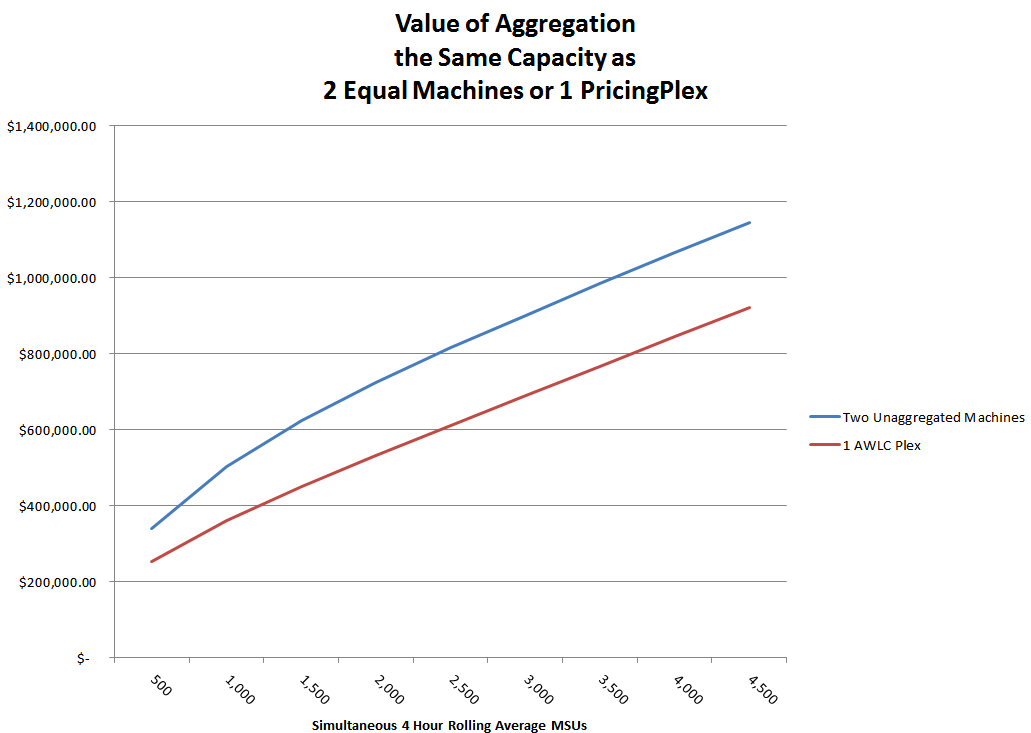Home > Updates
> Country Multiplex Pricing (this page)
Country Multiplex Pricing
Last Updated:
Tuesday, 23 May, 2017
IBM announced Country Multiplex Pricing (CMP) with US Announcement 215-230 on July 28, 2015. Country Mutliplex Pricing includes a number of important changes, including a new pricing metric (CMLC) for z/OS, new aggregation capability for both standalone machines and parallel sysplexes within a country, and Multiplex Version Measurement (MVM) replaces Single Version Charging (SVC). When you switch to CMP then SCRT will calculate a simultaneous four hour rolling average actoss all LPARs in all your CMP machines! Think about that for a minute, the effect should be lower billable MSUs for all your machines than the sum of the individual machine's billable MSUs. Even a single PricingPlex within a single data center could see lower software charges as the environment grows.
You should not expect CMP to initially lower your software charges. The value of CMP is the flexibility your have to rearrange your work and applications among your machines, and the removal of restrictions on where you may implement new applications. CMP removes the Parallel Sysplex aggregation rules that determined the PricingPlexes within your data centers. You will no longer be required to run IBM's PLEXCALC tool for verification.
This flexibility will make it easier to operate multiplex Parallel Sysplexes based on your business requirements without the need to be concerned with the software pricing implications.
Aggregation A key point to understand with CMP is IBM does not want to give up the pricing leverage they have with separate PricingPlexes. When an enterprise has multiple data centers each will have one or more separate PricingPlexes. Each variable sub capacity product in each PricingPlex pays for the most expensive MSUs in the lower tiers. The volume discount provided by aggregation starts over with 1 MSU in each of the PricingPlex. For a simple example consider just z/OS Base, CICS V5 and DB2 V10 in two separate 2,000 MSU PricingPlexes of zEC12 hardware. The software charges for each PricingPlex would be 533,421.45USD. Now consider if that was one pricingpliex rather than two of 4,000 MSUs. That single PricingPlex would be charged 845,294.65USD; a saving of 221,548.25USD due to the volume discount of aggregation.

The vertical distance between two separate machines priced individually (the blue line), or a single PricingPlex of the same capacity(the red line) shows the value. When IBM first discussed CMP the value for customers was described as future flexibility, not reduced software charges. IBM wants to maintain a consistent software revenue stream from each enterprise. Below 1,975 MSUs the charges for AWLC and CMLC are the same (after January 1, 2016). The new pricing tiers of CMLC lead to lower charges above 1,975 MSUs. The difference between two 2,000 MSU data centers and 4,000 MSU CMP pricing would be 236,951.24USD. In January IBM ddescribed a “base factor” to cover this otherwise lost revenue. The base factor quantifies the amount of savings due to CMP, and then uses that to uplift the CMLC pricing.
The original materials describing CMP showed the base factor being calculated on the difference in MSUs. Using MSUs did not compensate IBM for the lost revenue of the “expensive” lower tier MSUs. In the example above, which is a borderline case, the difference in MSUs is zero, yet the difference in revenue is 236,951.24USD. The Country Multiplex Pricing announcement changed the base factor calculation to reflect the difference in software charges. While this matches the intent IBM described it is a significant change.
Multiplex Version Measurement (MVM)Previously to CMP when a site is migrating to a new version of a product, for most custoemrs, IBM does not charge customers the SCRT MSUs of both versions. (Customers need to request Single Version Charging.) Since April 2005 with IBM's Workload License Charges a customer's invoice is based on the greater billable MSUs of either version on each machine. For example if you're converting form DB2 V10 to DB2 V11 some machines may have more MSUs for DB2 V10, while other machines have more SCRT MSUs for DB2 V11. Each machine's SCRT billable MSUs are aggregated within each PricingPlex and charged at the "prices" of the newer version.
CMP now creates a "virtual" product and determines the maximum simultaneous MSUs across any version, across all LPARs of all machines. This is Multiplex Version Measurement (MVM). It was officially renamed to "Multi-Version Measurement" with US announcment letter 217-093 on February 14, 2017. The concept and acronym are unchanged. This is shown in SCRT as a new row in the CSV. If CMP implemented Single Version Charging as previously, it would likely have used 5,314 MSUs in this example, as that is the larger MSUs of the two versions. MVM is going to lead to charges based on 5,499. 
Next Steps LCS software includes all the tools you need to analyze Country Multiplex Pricing today to determine the value to your environment. We also offer consulting services to help you understand both the initial value of CMP and the long term potential of CMP. You want an independant expert helping you with this analysis.
Last Updated:
Tuesday, 23 May, 2017
|













